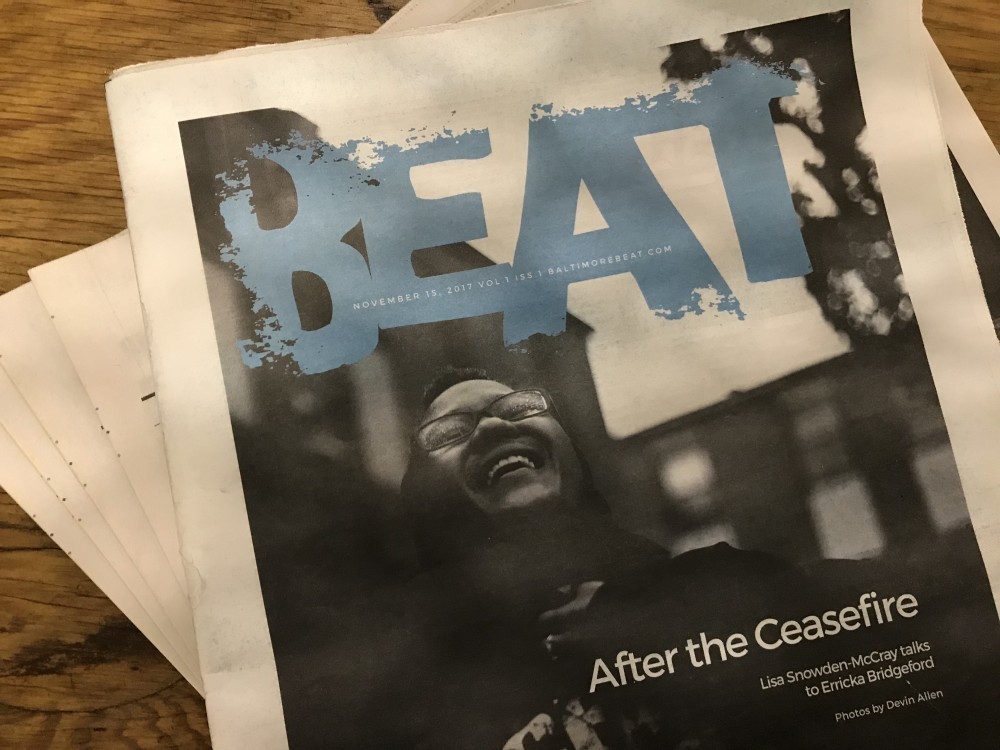
There is a notion in the zeitgeist that the media is the enemy of the people, that journalists are hucksters, peddling lies from an ivory tower of deceit. If any of this is true (none of this is true), someone forgot to tell the soon-to-be revived Baltimore Beat.
“We want to serve the community,” said Lisa Snowden-McCray, the once and future editor-in-chief of the Baltimore Beat. “We want to tell stories, but we also want people to know what’s going on and how it affects them.”
On March 6, exactly one year after its initial shuttering, the Beat will relaunch. Founded in 2018 by Snowden-McCray and Brandon Soderberg, both former staff members of City Paper, the Beat functioned as a spiritual successor, of sorts, to the historic alt-weekly, which was shut down the year prior. Although it only lasted four months, the first Beat—the anacrusis, if you will—quickly established itself in the local media scene with its unique perspective.
“Back at City Paper,” said Snowden-McCray, “I remember I went to the opening of a police station that was paid for, in part, by Under Armour. Most of the reporting was just, like, ‘Look at this nice new building,’ but the piece we published in City Paper was ‘Isn’t it kind of weird that Under Armour is paying for a police station?’”
It is this cocktail of serious and unserious that defined the Beat; reviews of marijuana (“Cherry Pie’s high comes fast and strong and stays for hours—also good for reggae listening”) were placed alongside award-winning coverage of the misdoings and corruption of the Baltimore Police Department (“Grave Concerns: Will Detective Suiter’s Death Bring Commissioner Davis Down?”). Even after a year-long hiatus, its ethos will remain the same, focusing on hyper-local issues that larger publications, such as The Baltimore Sun tend to ignore.
“We need to start treating issues that other places don’t see as enough to be a whole major investigative story,” said Soderberg, the Beat’s cofounder, “as if they’re beats that you need to cover. One of our readers told us that he wished someone consistently reported on lead—lead in schools, lead in housing, lead in our communities. There’s no way you could convince a corporate entity to pay someone to report on it consistently; it’s not particularly attractive, but it’s something that’s important and we have the ability and freedom to cover issues like that.”
Beyond the Beat’s irreverent tone and commitment to Baltimore minutiae—“the nuts and bolts,” as Snowden-McCray dubs it—the paper will differ from establishment media in another important way: it will be a digital-only publication. Granted, this is hardly a log gleefully lobbed at print media’s ashen funeral pyre; rather, it is a stark reminder of the financial restriction that the website faces.
In addition to eschewing printing, the Beat will also forego office space and advertising revenue. It will be a nonprofit publication, supported by private donations (its Patreon has 254 backers collectively pledging about $1,200 a month) and the Baltimore Institute for Nonprofit Journalism (BINJ), a foundation that Soderberg helped begin in 2017.
While the decision not to accept advertising money is financially limiting, it’s creatively freeing. Any executive with a baseball-sized windsor knot and a hankering for more listicles and quizzes will kindly be told to get lost.
“As a nonprofit,” said Soderberg, “our metrics aren’t hits or pageviews where people pay to advertise on those pages and expect something in particular. Our metrics are who’s donating and, then, how we can use that money. It gives us flexibility to try new and exciting things.”
In fact, Snowden-McCray and Soderberg will not have to listen to anyone besides themselves—since they’re the only staff members. Eventually, the Beat plans on establishing a deep bullpen of freelancers who, together, can capture the totality of the city, from the arts to the city council.
“I contributed to a piece in the Columbia Journalism Review,” said Snowden-McCray,“and they were looking at the number of people of color in newsrooms and the numbers are still very bad. I really want to be intentional about reimagining how we find writers, how we get talent. I want to be intentional about who we hire.”
And yet, there’s no guarantee that any of this can or will last. Media outlets at all levels—especially on the local one—are struggling to turn a profit; the industry on the whole has shrunk 23 percent since 2008. The Beat hopes to be an antidote to this trend, delivering old-school beat reporting via a unique financial structure.
“These structures that we’ve had in place for decades just aren’t working anymore,” Snowden-McCray said about the state of journalism, but, really, the world at large. “It feels more important to try than to be scared.”